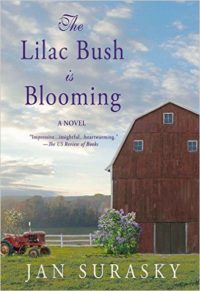Title: The Lilac Bush is Blooming
Author: Jan Surasky
Publisher: Sandalwood Press
ISBN: 978-0-988-277212
Pages: 290
Genre: Fiction
Reviewed by: Carol Davala
Hollywood Book Reviews
With all the downhome charm and appeal reminiscent of beloved Americana classics like Laura Ingalls Wilder’s “Little House” series, award-winning author Jan Surasky’s novel, “The Lilac Bush is Blooming,” reveals a beautiful coming-of-age story set in the 1950s amidst the pastoral countryside of central New York.
Through the first person narrative of young freckle-faced Annie May, readers are easily drawn into the life and history of the Parker family. Wedged between her older sister Carrie, the boy-crazy, beauty fashionista, and brother Georgie, the adored youngest, Annie May shines as the smart, reliable, and responsible middle child. In this rural environment hard work prevails, but it is generously laced with hearty buckwheat pancake breakfasts, county fairs, blue-ribbon cherry pies, and twinkling star-studded nightfalls. At its heart we see family and community revered.
When a curious Annie May discovers a stack of old journals in the attic, Surasky creatively weaves the narrative back in time through the archives of the family’s ancestry. Via letters and stylized language of the past, these volumes reveal events and emotional outpourings detailing the likes of an uncle serving as a soldier in the Civil War, a Native American descendant, a fortune-telling gypsy grandmother, and a kidnapper’s escape from indentured servitude. It is from these yellowed heirloom pages that the central character takes pride, in realizing the struggles and sacrifice her ancestors endured in an effort to seek a better life and procure greater opportunities for the generations to come.
In the present day, farming is a way of life for the Parker family. Clearly Surasky’s emphasis is on a lifestyle that revolves around the seasons. Here she details a natural landscape that takes us through the years. Growing up in New York State, and returning there to write and teach, the author undoubtedly draws on her own familiarity with the area to integrate the environment as an integral part of this fictional story. In this country realm, spring’s arrival is gauged by the vibrant bloom of the purple lilac bush rooted near the barn, while winter appears as a pristine wonderland of rolling, crystalline hills. Beauty abounds in this pictorial vista, filled with wild roses and delicate buttercups, or colorful autumnal foliage that twirls in the frosty air. As seasonal changes help to move the story forward, in a twofold purpose they also showcase the growth and evolving nature of the Parker family. From school days and summer loves, to graduations, weddings, and bountiful family reunions, life in this agricultural community are strengthened with milestone celebrations. Surasky also provides a new dimension beyond the farm, as readers witness the Parker girls venturing off to college, and young Georgie’s later draft into the Vietnam War. While unexpected casualties force detours in their chosen paths, familial bonds always remain at the heart of considerations. There seems a quickened pacing to the latter part of this work, perhaps symbolic of the changing circumstances for these characters, as well as a reflection of the times.
At its most basic level, this is a heartwarming novel with a storyline and dialogue that flows smoothly and easily. From a more complex point of view, it is a richly textured work filled with likeable characters that leave us with memories of joy, sorrow, and love. When young Georgie worries about losing family and friends to their individual pursuits, Annie May offers assurance in “No one ever leaves anyone when they love them.” Beyond the final pages of this feel good read, thoughts will remain of a solid, genuine family, connected not only to their land and historic heritage, but most importantly to each other.

